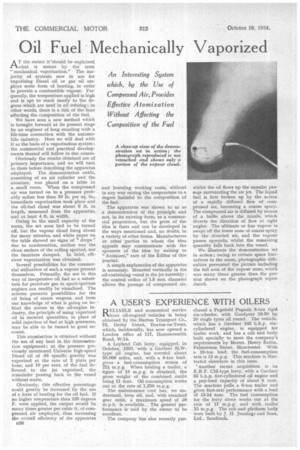Oil Fuel Mechanically Vaporized
Page 58

If you've noticed an error in this article please click here to report it so we can fix it.
An Interesting System which, by the Use of Compressed Air, Provides Effective Atomization Without Affecting the Composition of the Fuel
AT the outset it 'should be explained what . is meant by the term " mechanical vaporization." The majority of systems now in use for vaporizing Diesel oil or gas oil employs some form of heating, in order to provide a combustible vapour. Frequently, the temperature applied is high and is apt to reach nearly to the degrees which are used in oil refining ; in other words, there is a risk of the heat affecting the composition of the fuel.
We have seen a new method which is brought forward at its present stage by an engineer of long standing with a life-time connecticn with the automobile industry. Here we will deal with it as the basis of a vaporization system ; the commercial and practical developments thereof will follow in due course.
Obviously the results obtained are of primary importance, and we will turn to them before describing the apparatus employed. The demonstration outfit, consisting of an air cylinder and the atomizer, was placed on a table in a ,small room. When the compressed air was turned on to a pressure probably rather less than 10 lb. per sq. in., immediate vaporization took place and the oil-fuel cloud was about 6 ft. in length, measured from the apparatus, and at least 4 ft. in width.
Owing to the small capacity of the room, the set soon had to be turned off, but the vapour cloud hung about for many minutes, and white paper on the table showed no signs of " drops " due to condensation, neither was the clean surface of the ceiling spotted, nor the furniture damped. In brief, efficient vaporization was obtained. Several possibilities for the commercial utilization of such a vapour present themselves. Primarily, the use in this way of inexpensive oil fuel as a substitute for petrol-air gas in spark-ignition engines can readily be visualized. The scheme presents possibilities for the oil firing of steam wagons, and from our knowledge of what is going on behind the scenes in the oil-engine industry, the principle of using vaporized oil in metered quantities, in place of solid injection of fuel at high pressures, may be able to be turned to good account.
This atomization is obtained without the use of any heat in the demonstration equipment; at the pressure previously mentioned Universe high-speed Diesel oil of .84 specific gravity was vaporized at the rate of 2 pints per hour, and 10 per cent. of the fuel delivered to the jet vaporized, the remainder passing back to the vessel without waste.
Obviously, this effective percentage could greatly be increased by the use of a form of heating for the oil fuel. If no higher temperature than 120 degrees F. were applied, the output would be many times greater per cubic ft. of compressed air employed, thus increasing the overall efficiency of the apparatus c36 and lowering working costs, without in any way raising the temperature to a degree harmful to the composition of the fuel.
The apparatus was shown to us as a demonstration of the principle and not, in its existing form, as a commercial proposition, but the germ of the idea is there and can be developed in the ways mentioned and, no doubt, in a variety of other forms. Manufacturers or other parties to whom the idea appeals may communicate with the sponsors of the idea by writing to "Atomizer," care of the Editor of this journal.
A simple explanation of the apparatus is necessary. Mounted vertically in the oil-containing vessel is the jet assembly ; the central orifice of 1.5 mm. diameter allows the passage of compressed air,
whilst the oil flows up the annular passage surrounding the air jet. The liquid fuel is first broken up by the action of a rapidly diffused flow of compressed air, becoming a coarse spray. The compressed air is diffused by means of a baffle above the nozzle, which diverts the direction of flow at right angles. The ultimate or fine vapour is swept off the lower zone of coarse spray by the diverted air, and the vapour passes upwards, whilst the remaining quantity falls back into the vessel.
We illustrate the demonstration set in action ; owing to certain space limitations in the room, photographic difficulties prevented the picture including the full area of the vapour zone, which was many times greater than the portion shown on the photograph reproduced.












































































































